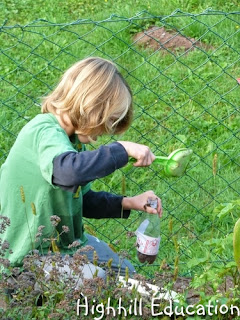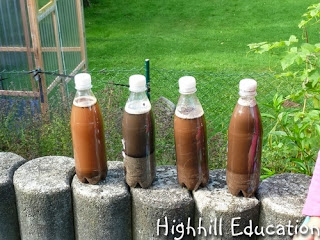When a river is shallow and slow the water can move small bits of dirt, but when a river is full, the raging water can be strong enough to move boulders. Packed within the story in the book Rocks, rivers & the changing earth,: A first book about geology are suggestions for many simple experiments.
Flood: Wrestling With The Mississippi
River Bed Sediment
To learn how water moves sediment in a river bed we first made a riverbed channel out of a piece of cardboard folded into U-shape.
The cardboard was filled with dirt containing rocks.
Next water was slowly poured down the channel and collected in a basin. Pouring slowly resulted in some dirt flowing along with the water.
Next the entire contents of the watering can were emptied into the channel resulting in the rocks and all the sediment flowing into the basin. This signifies a flood situation where the river is strong enough to move large boulders.
Settling Sediment
After this simple experiment, we learned how material settles on the bottom of a slow moving river.
First dirt was placed into an empty water bottle.
After adding water, the bottle was swished slowly and aloud to settle. During slow movement, only the smallest sediment was picked up by the water.
Repeating the experiment with rapid swishing resulted in more sediment being mixed with water.
After exploring the bottle a while, different materials were added to new bottles.
Then they were left to rest and examined at less frequent intervals.
After sitting for an hour the different layers of sediment became distinctly apparent.
Then, the next morning the water on top was completely clear showing how the sediment sinks to the bottom in a pond or very slow moving river.
Settling Trail Mix - The smallest materials sink to the bottom.
To reinforce the concept of the smallest materials settling on the bottom and biggest settling on the top, we made trail mix and shook it up.
The mix consisted of almonds, walnuts, peanuts, raisins, date pieces, dried fruit and tiny chocolate chips.
With gentle agitation the raisins and chocolate chips moved to the bottom while the almonds and walnuts rose to the top.
Now the kids know how to find the chocolate.
If you haven't seen our other science units make sure to check them out. There is a complete Cell and Human Body Unit Study to go with this nearly complete Earth Science Unit. They can all be found on the Science Page.
Be sure to check out these blog hops for more great kid educational activities.














Fantastic study! I'm glad they learned something practical in the end :)
ReplyDelete